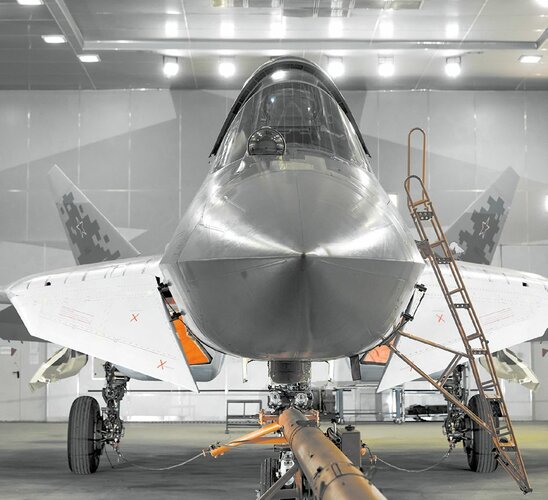I see. And i read it as PASSIVe and active. And again, KNIRTI is not a developer of radars for PAK FA, NIIP is.But you see this?
You are using an out of date browser. It may not display this or other websites correctly.
You should upgrade or use an alternative browser.
You should upgrade or use an alternative browser.
Sukhoi Su-57 / T-50 / PAK FA - flight testing and development Part II [2012-current]
tequilashooter
ACCESS: Top Secret
- Joined
- 1 January 2021
- Messages
- 699
- Reaction score
- 891
I see. And i read it as PASSIVe and active. And again, KNIRTI is not a developer of radars for PAK FA, NIIP is.But you see this?
i was wrong either way because Igor stated the functions of a fundamentally new radar for the pafka, not the existing EW system. You know the front, sides and behind view quote? I dont even care anymore it gets other users here worked on what the su-57 has or will not have. The Voltaire quote,"I disapprove of what you say,but I will defend your right to the death to say it." Doesnt apply here. I will drop the subject.
View: https://twitter.com/i/status/1390535336539852802

 defence-blog.com
defence-blog.com

Russian Su-57 fighters cause mysterious sound that frightened Moscow residents
Numerous people reported hearing the strange high-pitched ringing sound during a rehearsal of the Victory Day Parade in Moscow, while the four newest Russian Su-57 Felon fighter jets appeared in the sky. A Moscow resident has described hearing a mysterious ‘scary’ noise in the skies above the...
- Joined
- 29 November 2010
- Messages
- 1,738
- Reaction score
- 3,392
is it me or do they sound reminiscent of dive bombers like the Stutka
- Joined
- 11 February 2010
- Messages
- 1,558
- Reaction score
- 2,352
Gotta be the unique point of Su-57 now.
Cannonfodder43
ACCESS: Confidential
- Joined
- 8 December 2019
- Messages
- 114
- Reaction score
- 296
At what point does the Radar Blockers being the cause of the noise become common knowledge? It's been known they make that noise now for a while.
It's truly both amusing and infuriating how uninformed people truly are about the Felon.
It's truly both amusing and infuriating how uninformed people truly are about the Felon.
- Joined
- 11 February 2010
- Messages
- 1,558
- Reaction score
- 2,352
At what point does the Radar Blockers being the cause of the noise become common knowledge? It's been known they make that noise now for a while.
It's truly both amusing and infuriating how uninformed people truly are about the Felon.
At least it got people to click hahahaha.
-------------------
Anyway, something for fun. So yeah I did a little bit of experiment. I made myself a model of an inlet. With a simple Radar blocker and a compressor face with its respective Guide vanes.
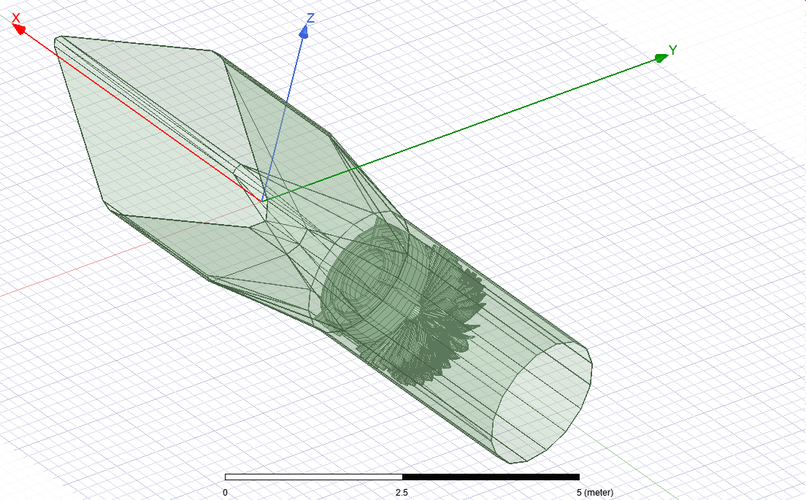
The radar blocker is just loosely based on the one in Su-57 patent. treatments that i did was to the leading edge of the Blocker where it would have ogival shaped edge to reduce contribution of RCS from the edge. The RAM Is the one from the "Radar Cross Section 2nd Edition" the Magnetic RAM Sintered-Zinc-Nickel-Ferrite.
The inlet Body is not treated and left as PEC, so does the engine face. The solution being used is SBR+ Which allows cavity RCS to be computed
The frequency being used here is L-band (1 GHz) because it's fast and can still enter the duct. Polarization is horizontal, and 3 conditions were taken as follows and the result in 2D contour projection :
| No Radar Blocker | Both radar blocker and engine face are made out of PEC (Perfect Electric Conductor) | Blocker is treated with Radar absorber |
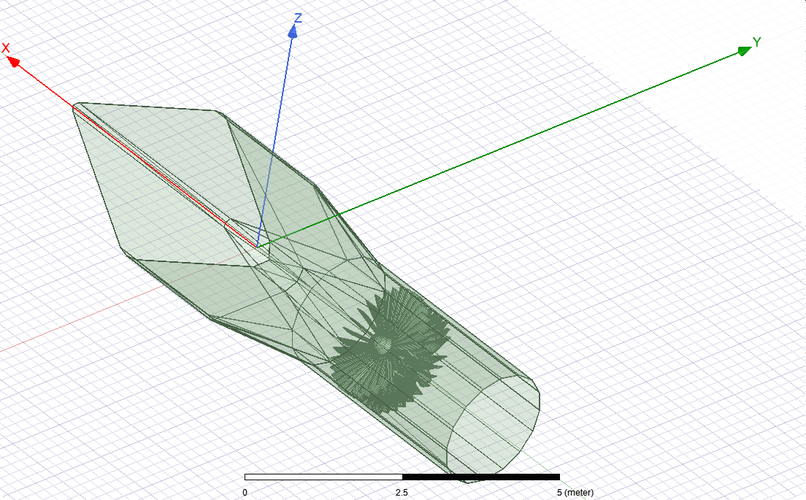
|

|

|
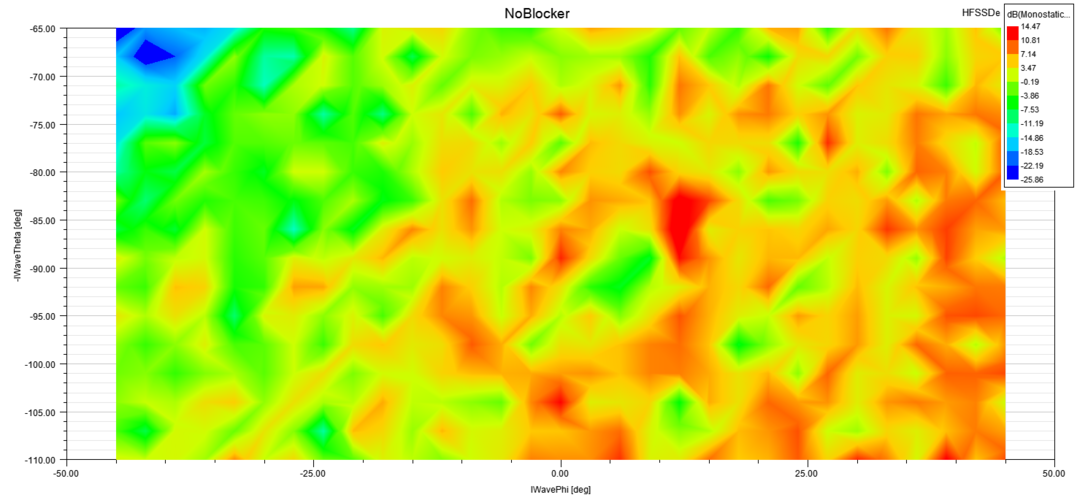
|
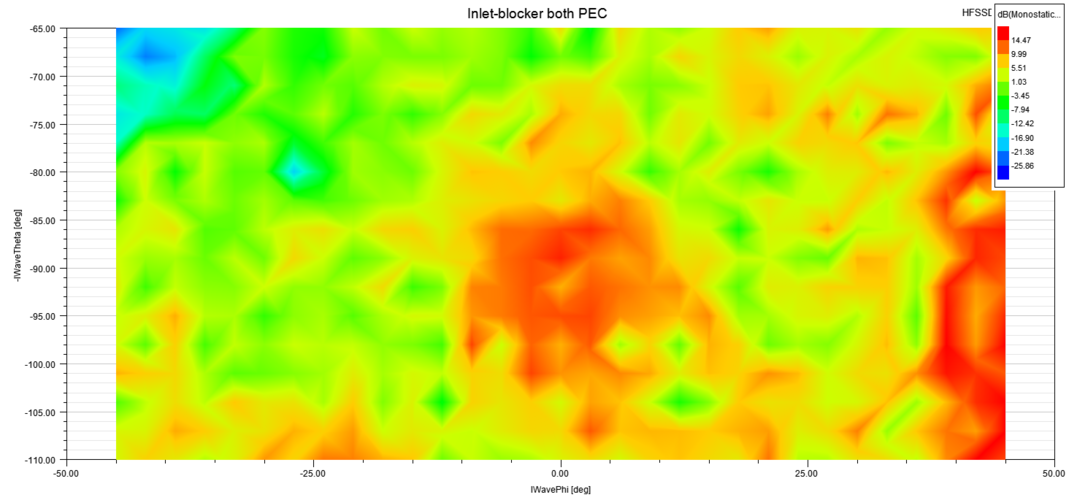
|
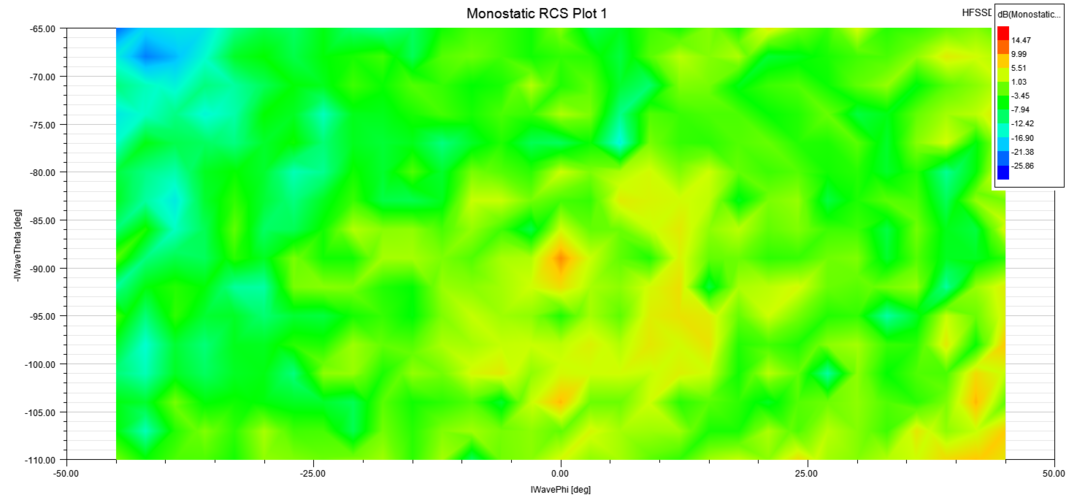
|
| Remarks : Relatively strong and broad reflections from the blades and guide vanes. | Remarks : Blocker and Inlet are basically compounding each other, produces strong reflections at the middle of the engine face. | Remarks : The radar blocker appears to be able to suppress the reflection of the blades behind it, "flare spots" appears to be reduced. |
The above projection are views from the front of the engine. Basically from this :
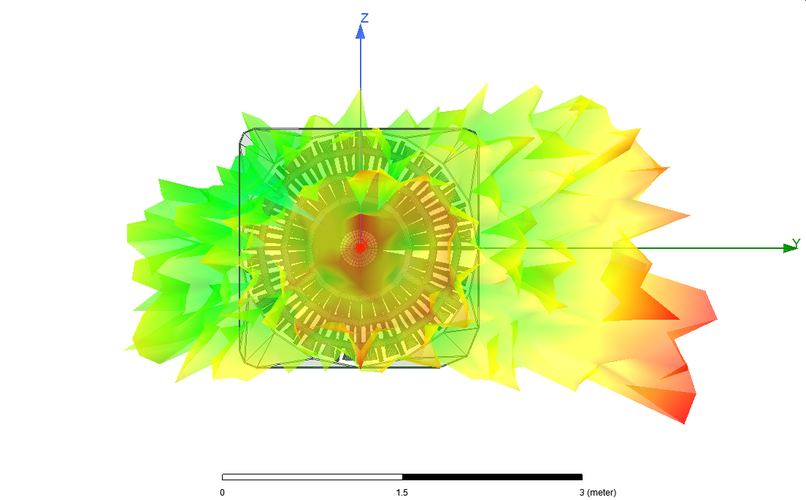
Numerical wise this is the Median of the inlet's RCS :

There is about 5-6 dB or 3-4 times of RCS reduction from above model. Doesnt sound like alot but still reduction. Plus i have no idea on how actually a radar blocker is designed. I wonder what kind of reduction a purposely designed and optimized radar blocker can have.
The subject of the design of radar blocker however appears to be rare in open literature so far. There are patents, but research papers are somewhat nonexistent. There are instead many on S-duct. Even the idea of ogival leading edge treatment for my simple radar blocker there came from paper dealing with S-duct (Attached):
Attachments
tequilashooter
ACCESS: Top Secret
- Joined
- 1 January 2021
- Messages
- 699
- Reaction score
- 891
Sweet is that a test result from a anechoic chamber or another guestimate like the south Korean 5th gen thread?
- Joined
- 11 February 2010
- Messages
- 1,558
- Reaction score
- 2,352
Obviously Guesstimate with ANSYS.Sweet is that a test result from a anechoic chamber or another guestimate like the south Korean 5th gen thread?
note that the inlet, blockers are just loosely based. Not gonna claim that would be the real signature. As i said above i have no idea how the blocker was actually designed.
tequilashooter
ACCESS: Top Secret
- Joined
- 1 January 2021
- Messages
- 699
- Reaction score
- 891
Obviously Guesstimate with ANSYS.
note that the inlet, blockers are just loosely based. Not gonna claim that would be the real signature. As i said above i have no idea how the blocker was actually designed.
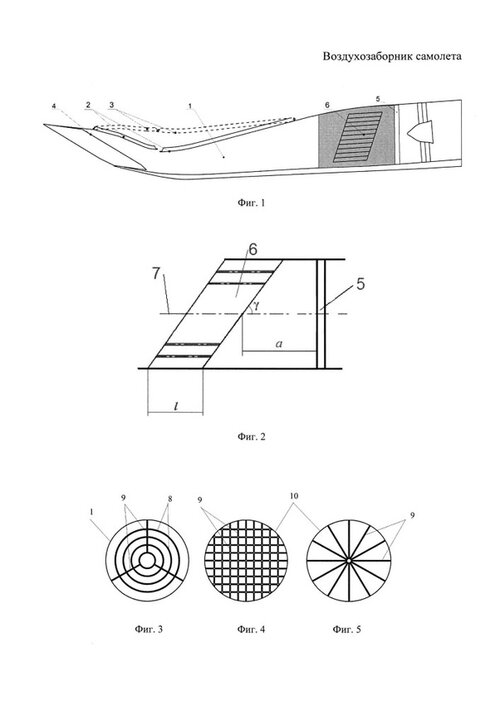
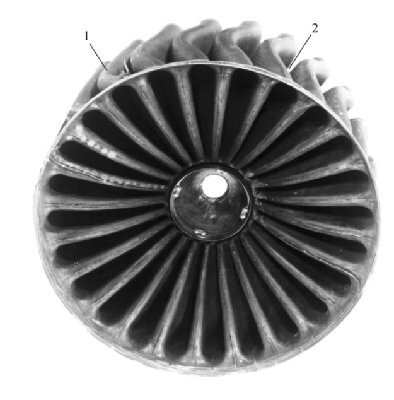
Got source from LMFS https://findpatent.ru/img_show/12839574.html
- There were partial S-ducts demonstrated on the patent itself. Meaning the fan blades are not completely exposed but partially.
- RAM is applied in the inlet.
- Patent and image shows radar blockers to reflect radio waves away from radar source and covering fan blades
- There is an anti-radar grading installed inside the air channel.
- Fan blades are made of composite materials
- Image of inlet vanes along with patent which are behind the blades are seen as being designed a particular way to lower RCS on bottom image.
- Joined
- 11 February 2010
- Messages
- 1,558
- Reaction score
- 2,352
Obviously Guesstimate with ANSYS.
note that the inlet, blockers are just loosely based. Not gonna claim that would be the real signature. As i said above i have no idea how the blocker was actually designed.
If you saw this patent before or not I don't know, just wondering if the above statements were taken into account of the model you made of the inlet? (I no you cant take in account the absorption properties of their RAM)
Well you should be able to see what i took into account in my post.
The only thing demonstrated from my observation above are that the blocker works. But it also opens up many question like how to optimize the shape. basically things you dont get from just the patent images. Or like why it shaped the way it is.
Anyway, something for fun. So yeah I did a little bit of experiment. I made myself a model of an inlet. With a simple Radar blocker and a compressor face with its respective Guide vanes.
Interesting! Some suggestions if I may:
1) Your inlet shape seems to be square with right angles in frontal projection, this is not accurate. The real inlet is a rhomboid which will probably affect the location of spikes.
2) Your blocker & engine face appear to be too close to the intake opening, which will probably impact things as well (especially in connection with #3).
3) It would be nice to see what coating the interior walls of the intake duct ahead of the blocker with RAM changes.
Acatomic
ACCESS: Secret
- Joined
- 18 October 2020
- Messages
- 203
- Reaction score
- 417
It's been bugging me for such a long time but today I finally remembered where I heard that sound - Cylon raiders from Battlestar Galacticais it me or do they sound reminiscent of dive bombers like the Stutka
Warning Spoilers!
- Joined
- 29 November 2010
- Messages
- 1,738
- Reaction score
- 3,392
doesn't the Super Hornet also use a similar blocker? and if so does it make a similar sound to the 57?
- Joined
- 11 February 2010
- Messages
- 1,558
- Reaction score
- 2,352
Well regarding the howling sound... How does the Sukhoi one compares to Hawker Hunter's famous "Blue note"
tequilashooter
ACCESS: Top Secret
- Joined
- 1 January 2021
- Messages
- 699
- Reaction score
- 891
Only problem with other aircrafts carrying blockers (besides the Su-57) I cant find patents for or what physical features they carry in shape if they compare to the su-57.doesn't the Super Hornet also use a similar blocker? and if so does it make a similar sound to the 57?
tequilashooter
ACCESS: Top Secret
- Joined
- 1 January 2021
- Messages
- 699
- Reaction score
- 891
1:10:20 Su-57 flight, little scream could be heard.
Avimimus
ACCESS: Top Secret
- Joined
- 15 December 2007
- Messages
- 2,296
- Reaction score
- 610
Well regarding the howling sound... How does the Sukhoi one compares to Hawker Hunter's famous "Blue note"
So that is where that sound comes from!!
TMA1
ACCESS: Top Secret
- Joined
- 6 February 2021
- Messages
- 542
- Reaction score
- 818
Saw this on another forum. It's from the parade that happened recently. It's obviously CG and it could just be added by the company mistakenly or even maybe some intentional disinformation. Still interesting it was even added. Horizontal louvres in the intake. What do you guys think?
Attachments
@TMA1 : Good screenshot.
I think you are right: they are probably trying to offer a quick answer to those trying to understand from where the witheling noise comes from (I can't see how such error would have been left unnoticed by Mil officials).
Honestly, it's a good explanation since those kind of louvres will certainly produce such witheling noise in the airstream.
But then, according to our knowledge so far, they are not part of the real Su-57.
I think you are right: they are probably trying to offer a quick answer to those trying to understand from where the witheling noise comes from (I can't see how such error would have been left unnoticed by Mil officials).
Honestly, it's a good explanation since those kind of louvres will certainly produce such witheling noise in the airstream.
But then, according to our knowledge so far, they are not part of the real Su-57.
Last edited:
paralay
ACCESS: Top Secret
The Russians won't be the first to build a hypersonic plane. This requires enormous expenses not only for the creation of such an aircraft, but even more for its operation.
Let the Americans, if they can, or the Chinese, first step into this "puddle"
Let the Americans, if they can, or the Chinese, first step into this "puddle"
Good joke.Tempest going for reaction engines for near hypersonic speeds
tequilashooter
ACCESS: Top Secret
- Joined
- 1 January 2021
- Messages
- 699
- Reaction score
- 891
1. Wont change the fact that lyulka developed the detonation engine. 2. The co-development 6th gen project that mikoyan and sukhoi are developing is separate to the 6th gen project mikoyan is developing for a interceptor.I am a little confused here, so this question is more like a survey. The F-35, NGAD and Russia's 6th gen I am assuming are heading for a 3 stream cycle engine design, correct? Is the FCAS really going for SABRE and Tempest going for reaction engines for near hypersonic speeds or will they just settle down for a 3 stream cycle engine design? I see more promise with a 6th gen interceptor Mig-41 getting detonation engines https://tass.ru/ekonomika/11103513 https://www.militarynews.ru/story.asp?lang=RU&nid=516338&rid= for a near hypersonic design than I do of the other two in my own opinion.
No more dreaming about pulse-detonation technology for PAK DP.

Минобороны заказало разработку оружия против гиперзвуковых ракет - МФРК ДП
Министерство обороны приняло решение о разработке нового многофункционального ракетного комплекса дальнего перехвата (МФРК ДП), способного перехватывать, в том числе, гиперзвуковое оружие. Об этом сообщают "Известия" со ссылкой на источники в Минобороны. Как пишет издание, в настоящее
@GARGEAN
darn that sucks https://www.defensenews.com/global/...cialist-reaction-engines-with-new-investment/
Last edited:
tequilashooter
ACCESS: Top Secret
- Joined
- 1 January 2021
- Messages
- 699
- Reaction score
- 891

Мантуров заявил, что предприятия промышленности готовятся к модернизации Су-57
По словам главы Минпромторга РФ, "это постоянный процесс"
MOSCOW, May 30. /TASS/. The defense-industrial complex is preparing for a new stage of modernization of the Russian fifth-generation Su-57 fighter. This was stated by the Minister of Industry and Trade denis Manturov on the air of the TV channel "Russia-1" in an interview for the program "Moscow. kremlin. Putin."
"The Su-57 has just entered service, only supplied, and we are already thinking and preparing for a new stage of modernization. This is an ongoing process," Manturov said, answering questions from journalist Pavel Sarubin.
haavarla
ACCESS: Secret
- Joined
- 29 June 2010
- Messages
- 200
- Reaction score
- 252
Its like the F-35 Block upgrade path. Expecting it be sensors and software driven.
Edit: About new engines, i think they will get installed as soon as they are ready, it doesn't really hinge on any block upgrade here.
Edit: About new engines, i think they will get installed as soon as they are ready, it doesn't really hinge on any block upgrade here.
Last edited:
are you referring to Izdeliye 30? or are they planning another engine further down the line?I assume Manturov refers to the Megapolis project to change the engines, actuators and cockpit, probably they will integrate also new weapons that have been in development for a while.
tequilashooter
ACCESS: Top Secret
- Joined
- 1 January 2021
- Messages
- 699
- Reaction score
- 891
Lets also not forget the new avionics 
LMFS
ACCESS: Top Secret
- Joined
- 19 March 2019
- Messages
- 525
- Reaction score
- 846
Izd. 30are you referring to Izdeliye 30? or are they planning another engine further down the line?
tequilashooter
ACCESS: Top Secret
- Joined
- 1 January 2021
- Messages
- 699
- Reaction score
- 891

Источник: истребитель Су-57 будет способен вести до четырех беспилотников "Охотник"
В ОАК ранее сообщили, что "Охотник" будет поражать воздушные и наземные цели в рамках сетецентрического взаимодействия с истребителем
The KLA previously reported that the "Okhotnik" will hit air and ground targets as part of the network-centric interaction with the fighter
MOSCOW, June 1. / TASS /. The pilot of the fifth generation Su-57 fighter will simultaneously coordinate the actions of four newest Hunter heavy attack unmanned aerial vehicles (UAVs). This was reported to TASS by a source in the aircraft industry.
"Now the possibilities of controlling several attack drones from the cockpit of the Su-57 are being worked out. It is assumed that the fighter will carry from two to four Hunters with it," he said.
Last edited by a moderator:
Acatomic
ACCESS: Secret
- Joined
- 18 October 2020
- Messages
- 203
- Reaction score
- 417
When talking about the future of the Russian Navy he mentioned an aircraft based on Su-57:

 ria.ru
ria.ru
- You said about a promising deck fighter. If it's not a Mig-29K or a Su-33, what?
- That's what aviation specialists should tell us. The Su-57 can be taken as a base, but the designers will have to count everything as the base of the aircraft on the ship. First of all, it is a folding wing, elements related to brake devices, because a conventional aircraft will not be able to perceive the dynamic loads associated with the hook when landing behind the hook.

Владимир Поспелов: новый авианосец может стоить от 500 миллиардов рублей
Коллегия Военно-промышленной комиссии Российской Федерации ведет работу по подготовке новой госпрограммы вооружений (ГПВ) на 2024-2033 годы. Какие приоритетные... РИА Новости, 18.05.2021
- Joined
- 9 October 2009
- Messages
- 21,147
- Reaction score
- 12,277
Does he mean it will be a Variable-Geometry design?First of all, it is a folding wing, elements related to brake devices, because a conventional aircraft will not be able to perceive the dynamic loads associated with the hook when landing behind the hook.
icyplanetnhc (Steve)
Trekking into the cosmic ocean
I've recently received Piotr Butowski's Su-57 book, and there are some rather interesting pieces of program history that I wasn't aware of. In no particular order I'll list a few of them off below, although it's by no means exhaustive.
During the now-defunct Indo-Russian FGFA saga, it seemed like the Indians from the beginning preferred the smaller Mikoyan E-721 design over the Sukhoi T-50; when the partnership was forming in 2005, Sukhoi's design was largely finalized, and India would rather pursue a less "mature" design like the E-721 where they can have more input into the design. Whether the FGFA cooperation was doomed to failure from the start is unknown, but there was definitely friction from the very beginning between India and Russia.
Unlike previous Sukhoi fighters, integration of mission systems and other onboard systems was performed by Sukhoi itself, rather than the traditional RPKB of Ramenskoye.
It appears that the AL-41F1 (izdeliye 117) is not quite as "interim" as many have believed; while I think there was always a longer term goal of equipping the aircraft with new engines, it appears that the plan has always been for the PAK FA to enter production and serve in combat units with the AL-41F1, and this was decided as far back as 2004. In fact, it appears that Sukhoi's T-50 submission for the PAK FA had the AL-41F1 from the very beginning. This is an interesting contrast with the Su-27, where the T-10 prototypes used the AL-21, but the revised T-10S and the production aircraft were equipped with the AL-31 from the beginning.
Apparently, weapon firing from internal bays didn't occur until March 2016.
The Su-57 has certainly suffered from weight creep compared to what was originally planned. I recalled the original goal was for an aircraft to be somewhere between the MiG-29 and Su-27 in size, in an effort to rein in cost. Certainly the Su-57 that's in production today is much closer to the Su-27 in terms of size, and especially after the "second stage" structural rework.
During the now-defunct Indo-Russian FGFA saga, it seemed like the Indians from the beginning preferred the smaller Mikoyan E-721 design over the Sukhoi T-50; when the partnership was forming in 2005, Sukhoi's design was largely finalized, and India would rather pursue a less "mature" design like the E-721 where they can have more input into the design. Whether the FGFA cooperation was doomed to failure from the start is unknown, but there was definitely friction from the very beginning between India and Russia.
Unlike previous Sukhoi fighters, integration of mission systems and other onboard systems was performed by Sukhoi itself, rather than the traditional RPKB of Ramenskoye.
It appears that the AL-41F1 (izdeliye 117) is not quite as "interim" as many have believed; while I think there was always a longer term goal of equipping the aircraft with new engines, it appears that the plan has always been for the PAK FA to enter production and serve in combat units with the AL-41F1, and this was decided as far back as 2004. In fact, it appears that Sukhoi's T-50 submission for the PAK FA had the AL-41F1 from the very beginning. This is an interesting contrast with the Su-27, where the T-10 prototypes used the AL-21, but the revised T-10S and the production aircraft were equipped with the AL-31 from the beginning.
Apparently, weapon firing from internal bays didn't occur until March 2016.
The Su-57 has certainly suffered from weight creep compared to what was originally planned. I recalled the original goal was for an aircraft to be somewhere between the MiG-29 and Su-27 in size, in an effort to rein in cost. Certainly the Su-57 that's in production today is much closer to the Su-27 in terms of size, and especially after the "second stage" structural rework.
Last edited:
icyplanetnhc (Steve)
Trekking into the cosmic ocean
Also, Sukhoi's approach to the PAK FA competition at the program level was fundamentally different from Mikoyan's. Mikoyan had planned for a more collaborative consortium-like approach between the design bureaus, while Sukhoi believed that it can win the competition by itself and directly contacted avionics and propulsion suppliers as well as research facilities to create a "complete system" from a program perspective.
Envelope expansion by February 2014 was up to Mach 1.7, 1,000 km/h IAS, 14,000 m ceiling, and 6 g. There was a lull in testing around that time, especially state trials at Akhtubinsk, due to the need for structurally reinforced airframes.
The second phase of state trials, GSI-2, would actually qualify the aircraft as a weapons system, and was supposed to end in 2019, but I’m not sure if that had actually occurred. Entry into service was delayed by the crash of the first production aircraft in December 2019.
To be fair, the book's title is in all capital letters, so it's merely a stylistic choice.
Envelope expansion by February 2014 was up to Mach 1.7, 1,000 km/h IAS, 14,000 m ceiling, and 6 g. There was a lull in testing around that time, especially state trials at Akhtubinsk, due to the need for structurally reinforced airframes.
The second phase of state trials, GSI-2, would actually qualify the aircraft as a weapons system, and was supposed to end in 2019, but I’m not sure if that had actually occurred. Entry into service was delayed by the crash of the first production aircraft in December 2019.
Also, the capital U in the title of that book annoys me to no end. It is Su-57 goddamit. It is always Su.
To be fair, the book's title is in all capital letters, so it's merely a stylistic choice.
Last edited:
- Joined
- 11 February 2010
- Messages
- 1,558
- Reaction score
- 2,352
The Su-57 has certainly suffered from weight creep compared to what was originally planned. I recalled the original goal was for an aircraft to be somewhere between the MiG-29 and Su-27 in size, in an effort to rein in cost. Certainly the Su-57 that's in production today is much closer to the Su-27 in terms of size, and especially after the "second stage" structural rework.
Empty weight wise ?
icyplanetnhc (Steve)
Trekking into the cosmic ocean
Almost certainly. Originally, the target normal takeoff weight (presumably air-to-air load and a certain percentage of internal fuel) was 22-23 metric tons, whereas now it's 25 metric tons by most accounts. The book also stated that the "second stage" structural rework has also increased weight somewhat.The Su-57 has certainly suffered from weight creep compared to what was originally planned. I recalled the original goal was for an aircraft to be somewhere between the MiG-29 and Su-27 in size, in an effort to rein in cost. Certainly the Su-57 that's in production today is much closer to the Su-27 in terms of size, and especially after the "second stage" structural rework.
Empty weight wise ?
Incidentally, there was also a chart in the KNAAZ factory showing the distribution of materials in the PAK-FA/Su-57. By mass, the airplane is 40.5-44.5% aluminum alloys, 22-26% composites, 18.6% titanium alloys, 10.7% steel. Composites do make up about 70% of the outer surface.
Last edited:
Similar threads
-
Sukhoi PAK FA news and speculation (T-50, I-21) Part II [2008-2009]
- Started by overscan (PaulMM)
- Replies: 451
-
Sukhoi Su-57 / T-50 / PAK FA first flight - pictures, videos and analysis [2010]
- Started by flateric
- Replies: 872
-
Sukhoi Su-57 / T-50 / PAK FA - flight testing and development Part I [2010-2012]
- Started by Matej
- Replies: 760
-
Sukhoi PAK FA news and speculation (T-50, I-21) Part I [2006-2008]
- Started by overscan (PaulMM)
- Replies: 455
-
Vladimir Sergeevich Ilyushin 31-03-1927 - 01-03-2010
- Started by flateric
- Replies: 4



